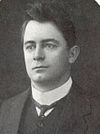
Sir Earle Christmas Grafton Page was an Australian politician and surgeon who served as the 11th prime minister of Australia from 7 to 26 April 1939, holding office in a caretaker capacity following the death of Joseph Lyons. He was the leader of the Country Party from 1921 to 1939, and was the most influential figure in its later years.

The Third Fisher ministry (Labor) was the 10th ministry of the Government of Australia. It was led by the country's 5th Prime Minister, Andrew Fisher. The Third Fisher ministry succeeded the Cook ministry, which dissolved on 17 September 1914 following the federal election that took place on 5 September which saw Labor defeat Joseph Cook's Liberals. The ministry was replaced by the First Hughes ministry on 27 October 1915 following Fisher's retirement from Parliament to become the next High Commissioner to the United Kingdom.

The Fourth Hughes ministry (Nationalist) was the 14th ministry of the Government of Australia. It was led by the country's 7th Prime Minister, Billy Hughes. The Fourth Hughes ministry succeeded the Third Hughes ministry, which dissolved on 8 January 1918 following the resignation of Hughes as prime minister after a vote of no-confidence within the Nationalist Party in the wake of a failed second referendum on conscription. However, due to a lack of alternative leaders, Hughes was immediately re-commissioned as prime minister by Governor-General Sir Ronald Munro Ferguson. The ministry was replaced by the Fifth Hughes ministry on 3 February 1920 following the 1919 federal election.

The First Bruce ministry was the 16th ministry of the Government of Australia. It was led by the country's 8th prime minister, Stanley Bruce. The First Bruce ministry succeeded the Fifth Hughes ministry, which dissolved on 9 February 1923 following the December 1922 federal election and the subsequent resignation of Billy Hughes as prime minister. The Nationalists had lost their majority in the election, and had no choice but to negotiate a Coalition deal with the Country Party. However, Country leader Earle Page let it be known that no deal could be made unless Hughes resigned. It is the first ministry that consists of a centre-right Coalition between the senior conservative party and the junior rural party - this Coalition has more or less endured to this day with the modern-day Liberal Party and National Party. The ministry was replaced by the Second Bruce ministry on 18 December 1925 following the 1925 federal election.
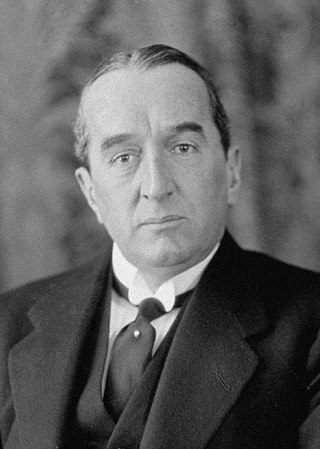
The Second Bruce ministry was the 17th ministry of the Government of Australia. It was led by the country's 8th Prime Minister, Stanley Bruce. The Second Bruce ministry succeeded the First Bruce ministry, which dissolved on 18 December 1925 following the federal election that took place in November. The ministry was replaced by the Third Bruce ministry on 29 November 1928 following the 1928 federal election.

The Third Bruce ministry was the 18th ministry of the Government of Australia. It was led by the country's 8th Prime Minister, Stanley Bruce. The Third Bruce ministry succeeded the Second Bruce ministry, which dissolved on 29 November 1928 following the federal election that took place in November. The ministry was replaced by the Scullin ministry on 22 October 1929 following the federal election that took place on 12 October which saw Labor defeat the Coalition. That election also saw Bruce lose his own seat of Flinders; no sitting Prime Minister would lose his own seat again until 2007.

The Scullin ministry (Labor) was the 19th ministry of the Government of Australia. It was led by the country's 9th Prime Minister, James Scullin. The Scullin ministry succeeded the Third Bruce ministry, which dissolved on 22 October 1929 following the federal election that took place on 12 October which saw Labor defeat Stanley Bruce's Nationalist–Country Coalition. The ministry was replaced by the First Lyons ministry on 6 January 1932 following the federal election that took place in December which saw the United Australia Party defeat Labor. As of 2022, it remains the most recent government to have lost an election after a single term in office.
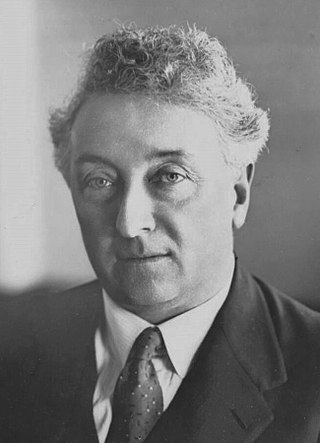
The Second Lyons ministry was the 21st ministry of the Government of Australia. It was led by the country's 10th Prime Minister, Joseph Lyons. The Second Lyons ministry succeeded the First Lyons ministry, which dissolved on 12 October 1934 following the federal election that took place in September. However, it was a minority government relying on support from the Country Party in order to remain in office. The ministry was replaced by the Third Lyons ministry on 9 November 1934 after Lyons entered into a formal Coalition with Earle Page and his Country Party; the second such coalition after that of the Bruce government.

The Third Lyons ministry was the 22nd ministry of the Government of Australia. It was led by the country's 10th Prime Minister, Joseph Lyons. The Third Lyons ministry succeeded the Second Lyons ministry, which dissolved on 9 November 1934 after Lyons entered into a formal Coalition with Earle Page and his Country Party; the second such coalition after that of the Bruce government. The ministry was replaced by the Fourth Lyons ministry on 29 November 1937 following the 1937 federal election.

The First Chifley ministry (Labor) was the 32nd ministry of the Government of Australia. It was led by the country's 16th Prime Minister, Ben Chifley. The First Chifley ministry succeeded the Forde ministry, which dissolved on 13 July 1945 following the election of Chifley as Labor leader after the death of former Prime Minister John Curtin. The ministry was replaced by the Second Chifley ministry on 1 November 1946 following the 1946 federal election.

The Fourth Menzies ministry was the 34th ministry of the Government of Australia. It was led by the country's 12th Prime Minister, Robert Menzies. The Fourth Menzies ministry succeeded the Second Chifley ministry, which dissolved on 19 December 1949 following the federal election that took place on 10 December which saw the Coalition defeat Ben Chifley's Labor Party. The ministry was replaced by the Fifth Menzies ministry on 11 May 1951 following the 1951 federal election.

The Fifth Menzies ministry was the 35th ministry of the Government of Australia. It was led by the country's 12th Prime Minister, Robert Menzies. The Fifth Menzies ministry succeeded the Fourth Menzies ministry, which dissolved on 11 May 1951 following the federal election that took place in April. The ministry was replaced by the Sixth Menzies ministry on 9 July 1954 following the 1954 federal election.

The Sixth Menzies ministry was the 36th ministry of the Government of Australia. It was led by the country's 12th Prime Minister, Robert Menzies. The Sixth Menzies ministry succeeded the Fifth Menzies ministry, which dissolved on 9 July 1954 following the federal election that took place in May. The ministry was replaced by the Seventh Menzies ministry on 11 January 1956 following the 1955 federal election.
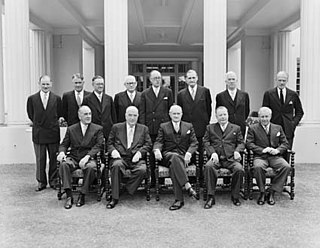
The Seventh Menzies ministry was the 37th ministry of the Government of Australia. It was led by the country's 12th Prime Minister, Robert Menzies. The Seventh Menzies ministry succeeded the Sixth Menzies ministry, which dissolved on 11 January 1956 following the federal election that took place in the previous December. It is the first ministry to consist of a two-tier ministry, with only senior ministers being members of Cabinet, while the other ministers are in the outer ministry. With the exception of the Whitlam government and the caretaker First Fraser ministry, this practice has endured to this day. The ministry was replaced by the Eighth Menzies ministry on 10 December 1958 following the 1958 federal election.

The First Holt Ministry was the 41st ministry of the Government of Australia. It was led by the country's 17th Prime Minister, Harold Holt. The First Holt ministry succeeded the Tenth Menzies ministry, which dissolved on 26 January 1966 following the retirement of former Prime Minister Sir Robert Menzies. The ministry was replaced by the Second Holt ministry on 14 December 1966 following the 1966 federal election.
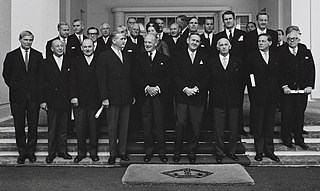
The First Gorton ministry was the 44th ministry of the Government of Australia. It was led by the country's 19th Prime Minister, John Gorton. The First Gorton ministry succeeded the McEwen ministry, which dissolved on 10 January 1968 following the election of Gorton as Liberal leader after the disappearance of former Prime Minister Harold Holt. The ministry was replaced by the Second Gorton ministry on 12 November 1969 following the 1969 federal election.

The Second Gorton ministry was the 45th ministry of the Government of Australia. It was led by the country's 19th Prime Minister, John Gorton. The Second Gorton ministry succeeded the First Gorton ministry, which dissolved on 12 November 1969 following the federal election that took place in October. The ministry was replaced by the McMahon ministry on 10 March 1971 following the resignation of Gorton.
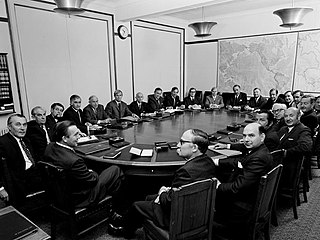
The McMahon ministry was the 46th ministry of the Australian Government. It was led by the country's 20th Prime Minister, William McMahon. The McMahon ministry succeeded the Second Gorton ministry, which dissolved on 10 March 1971 following the resignation of John Gorton as Prime Minister. The ministry was replaced by the First Whitlam ministry on 5 December 1972 following the federal election that took place on 2 December which saw Labor defeat the Coalition.
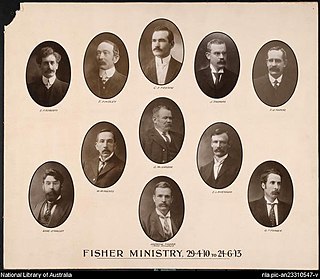
The Second Fisher ministry was the 8th ministry of the Government of Australia. It was led by the country's 5th Prime Minister, Andrew Fisher. The Second Fisher ministry succeeded the Third Deakin ministry, which dissolved on 29 April 1910 following the federal election that took place on 13 April which saw Labor defeat the Alfred Deakin's Liberal Party. It is the first federal government in Australian history to be elected with a majority in the House of Representatives, as well as the first majority national Labor government in the world. The ministry was replaced by the Cook ministry on 24 June 1913 following the federal election that took place in May which saw the Liberals defeat Labor.

Sir George Foster Pearce KCVO was an Australian politician who served as a Senator for Western Australia from 1901 to 1938. He began his career in the Labor Party but later joined the National Labor Party, the Nationalist Party, and the United Australia Party; he served as a cabinet minister under prime ministers from all four parties.











